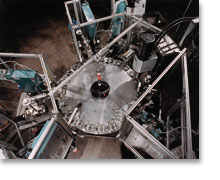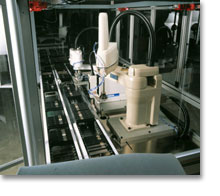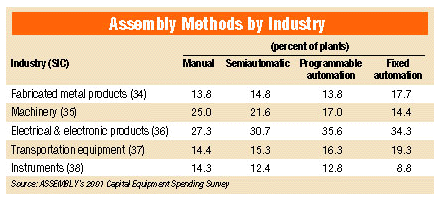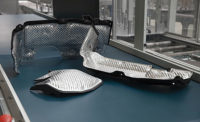Basic questions about the product have to be addressed before requests for quotations (RFQs) are issued for an assembly project.
One of my summer jobs as a college student was at a bottling plant. Machines automatically filled, capped and labeled the bottles. Then a co-worker and I manually applied safety seals to the bottles and put them in boxes. We also made sure the machines were adequately supplied with caps and empty bottles.
It wasn't a bad job. The pay was decent, and the hours were good. But, after hour upon hour of applying safety seals, I often wondered: "Couldn't the company get a machine to do this, too?"
The question is more complicated than I could have imagined at the time. For the manufacturing engineers to make an intelligent decision about automating the process, they'd need answers to dozens of other questions. Could the seals be fed automatically? Could the machine apply more than one seal size? How long would the bottling company use this type of seal? Were funds available to buy a machine? And, would the cost of operating and maintaining the machine exceed the cost of hiring cash-strapped college students?
Manufacturing engineers must go through the same calculus when deciding how to assemble a product at a particular quantity, quality and cost. If production volume is high, the assembly tasks are simple and the product's market life is long, a fully automatic, multistation assembly system will be easy to justify. For most products, however, the decision to use manual, semiautomatic or fully automatic assembly methods is rarely so clear-cut.
Bob Rice, director of engineering at ATC Automation, says only 30 percent of his customers know exactly what type of assembly system they need--and those customers are usually automotive suppliers with decades of experience with assembly automation. "Most of our customers just know what they want to accomplish and the rate at which they want to accomplish it," he says. "They leave the system up to us."

The Numbers Game
Annual production volume has the most influence on the choice of assembly method, according to Paul Beduze, director of sales at IMA Automation North America. "It's hard to justify a lot of automation for a product that costs a dime, unless you're making 30 million of them a year," he explains. "The more volume you have, the shorter your return on investment period will be."
Beduze's starting point for automated assembly is 3 million units per year. At smaller volumes, an automation project can be justified if, for example, the parts are expensive or the product has a large number of assembly steps. An ideal candidate for automated assembly should have at least three assembly steps, Beduze says.
Because it may not require feeder bowls and other equipment, a semiautomatic assembly system is less expensive than a fully automatic one. But, a semiautomatic system will be unable to produce millions of units per year without a large number of workers, Beduze says.
By knowing annual production volume, engineers can determine the rate, in units per minute, at which the system must operate. The production rate can establish--and be influenced by--the number of shifts the plant operates. The rate can also be influenced by estimates of the system's overall efficiency.
"If you need one part per minute, that's typically a manual operation. If you need 60 parts per minute, that's automation," says Rice. "It takes 5 to 6 seconds to manually load anything. If you don't have 5 or 6 seconds, then you need automation."

If annual production volume is expected to change significantly, engineers have another problem to consider: Bite the bullet, and invest in a fully automated system right away. Or, find a lower-cost middle-ground solution and upgrade later.
New products are seldom assembled in massive quantities from the start. There's usually a ramp-up period. A manufacturer might make 100,000 assemblies the first year, 400,000 the next year, and 1 million the year after that.
Often, products take longer to come up to the expected volume. So, rather than build a machine that does 1 million widgets right away, one possibility is to build two smaller machines a year or two apart. The first machine can carry you for the first couple of years.
As a bonus, the two-machine solution gives manufacturers an insurance policy against breakdowns. A single high-speed line might be cost-effective, but disaster looms if the line goes down for a long time.
Another way around the ramp-up problem is to build an asynchronous line consisting of modular automated workcells connected by pallet-style conveyors, says Beduze. With this approach, manufacturers can add or subtract cells as needs change.
The workcell approach also addresses the issue of flexibility by providing process-based automation rather than product-based automation. Companies should decide which processes they want to keep as their foundation for automation. Then, they can design their products around those processes so they have an inherently more flexible system.
Looking at the Product
The choice of assembly method is not entirely determined by volume needs. Many other issues come into play.
The market life of the product is one consideration. The high cost of an automated assembly system is usually amortized over several years. You don't want to assemble something with a fully automated system if you're only going to produce it for a year.
The cost and availability of the labor force is another issue. You might have more manual operations in Juarez, Mexico, but you might have more automated operations in the United States.
On the other hand, low-cost labor might not have the technical skill to handle every aspect of assembly, Beduze points out. For example, if the product requires sophisticated electrical testing, it might make more sense to assemble the product "at home" on an automated system. The money saved by eliminating low-cost assemblers can then be spent on workers who are skilled in testing.
The complexity of the product can determine which, if any, assembly processes are automated. In some cases, manufacturers are better off delaying the decision to automate until complex processes can be prototyped.

The Quality Question
Part quality is an often overlooked detail that can significantly influence the choice of assembly method. When a product is assembled manually, operators visually inspect the parts and reject bad ones. In an automated assembly system, bad parts often cause jams that stop production.
Even if 99.95 percent of the parts are acceptable, that may not be good enough for efficient automated assembly, according to Dean A. Shafer, PE, in Successful Assembly Automation (Society of Manufacturing Engineers, 1999). For example, consider an automated assembly system that produces a five-part product at a rate of 50 units per minute. Assuming every faulty part causes a machine jam and clearing a jam takes 2 minutes, a defect rate of "only" 500 parts per million will cause the system to be down 20 percent of the time. If machine speed increases to 500 units per minute, the system will be down more than 70 percent of the time!
As a result, manufacturing engineers must assess the quality of incoming parts. To accommodate automated assembly, engineers may have to adjust part tolerances or modify part-handling options.
The quality issue can work the other way, too. If a part has a minor defect, an operator may be able to complete the assembly, but the finished product may not meet specifications. One advantage of automated assembly is that it ensures products will consistently meet quality standards. Every part is assembled exactly the same way. The system will stop when bad parts are encountered, or the system can be designed to reject assemblies that do not meet specifications.
With the right fixtures and methods, workers using manual or semiautomatic assembly equipment can minimize quality problems, says Beduze. "But, if you ask an operator to insert a small ball into a part every time, it's not going to happen. There's going to be some degree of error," he says. "Unless it breaks down, an automated assembly system will always turn out quality product."
On the other hand, says Beduze, quality costs money, and assemblers can lower the initial cost of an assembly system by reducing or eliminating inspection stations. "Vision systems are not cheap," he says. "You can put operators between automated assembly modules to inspect the product. You can always add a vision system later, as volume increases."
As a result, assemblers should carefully consider the importance of quality to their product, as well as the cost of achieving that standard. If you're making safety devices, you are very concerned about inspections and ensuring that absolutely no rejects enter the product stream. If you're making bricks, you don't need that level of quality.
In or Out?
The goal of reducing cycle time encourages the integration of operations. The fastest cycle time can often be achieved by linking all process steps together into one line. However, this can be a disaster if the reliability and interaction of each operation are not well understood.
Fastening, ultrasonic welding, snap-fit insertion, O-ring installation, labeling and other straightforward, consistent processes are easily automated, says Steven Kinderman, sales engineering manager at Isthmus Engineering & Manufacturing (Madison, WI). Inconsistent processes that don't have hard, definable components, such as fluid dispensing or placing foam parts, are more difficult to integrate.
"They're not impossible, but they're challenging. They definitely bring risk into the system," says Kinderman.
Balancing process times is critical. Adhesive curing, electrical testing and leak testing take more time than fastening or press-fitting. As speed increases, the options for fastening decrease. Ultrasonic welding is popular for joining plastic parts. However, there may not be enough time for ultrasonic welding in a high-speed assembly system. Snap-fits or cold-staking may work better.
A simple method for comparing the complexity of different assembly systems is to add the number of parts, placements and process steps. Simple steps, such as verification of a placement, can be ignored, but process steps, such as welding or testing, should be counted. If the total is greater than 15, engineers should consider dividing assembly of the product among two machines, with a buffer between. If the number is low--five to seven--higher speed methods, such as continuous motion, may be possible. If the number is greater than 20, a nonsynchronous assembly system should be considered.
A nonsynchronous line should also be considered if manufacturers have to account for downtime of upstream processes, such as molding plastic components.
"If some components require more assembly time than others, you may have to separate them in an asynchronous system," says Kinderman. "For example, you might have two or three parts that must be ultrasonically welded. The only way to meet cycle time is to do that in a 'multi-up' fixture. If other processes on the line can easily be done in a 'one-up' fixture, you want an asynchronous operation."
In contrast, a synchronous system might consist of four 1-second operations that can be done progressively.
Working Together
Interdepartmental cooperation is critical to the success of assembly projects. The marketing department must provide manufacturing with realistic estimates of minimum and maximum production requirements. Design engineers should get input from manufacturing engineers so that the timing of assembly processes can be worked out on the drawing board instead of on the machine.
"Product designers aren't experts in automation. They're more worried about the function of the product than how it's put together," says Rice.
As a result, the design engineer often hands off the product to the manufacturing engineer, who, in turn, hands it off to the machine builder. "When we get it, we find that each of the assembly processes take 2 seconds, except for a heat-curing operation that takes an hour," says Rice. If the manufacturing engineer and the machine builder had been involved earlier, they could have recommended a faster-curing UV adhesive.
Manufacturers are well-advised to involve their machine builder as soon as possible. The sooner manufacturers can talk to their automation suppliers, the better it is. There are always suggestions integrators can make to reduce manufacturing costs and improve product quality. The later engineers bring integrators in, the tougher it is to make changes in the product.
Simulation Saves Time and Money
During test runs of a new robotic assembly line at a cell phone manufacturer, a disturbing fact quickly became apparent. Someone goofed.
The pallets at a particular station were beyond the reach of the robot's work envelope. The company's manufacturing engineers quickly found a work-around. Simply rotating the pallet 90 degrees brought the parts within the robot's reach.
Unfortunately, nothing in manufacturing is ever that tidy. The work-around created another problem. The fixture was designed to hold the parts in the original direction. Rotated, the fixture could not adequately support the parts during processing.
When the problem was finally solved, the manufacturer had lost days of production time.
Computer simulation might have solved the phone maker's problems before a single fixture was cut and before any robot hit the shop floor. Software is available to simulate product assembly, robotic workcells and entire lines. In many cases, the software can import files directly from CAD programs.
With product assembly simulation, engineers can test parts for fit and check how dimensional tolerances stack up. Assemblies can be tested thousands of times to see how changes in dimensions or tolerances affect efficiency. That type of experiment can't be done with a handful of prototype parts that may fit together fine.
Simulation allows manufacturing engineers to give designers specific feedback. Rather than say, "This won't work," you can say, 'This hole needs to be this much wider."
Assembly simulation also gives engineers insight into how part designs and processes will affect yield. By grading material characteristics, part complexity and assembly processes, simulation can tell engineers if the product is suitable for automated assembly. It won't tell you not to use screws, but it will tell you the cost associated with using them.
With workcell simulation, engineers can see how changes in equipment and layout affect cycle time. They can see how parts will behave in feeders. They can get a jump on machine programming and wiring plans. And, they can check that a robot's work envelope encompasses everything it needs.
Once you cut metal and write code, it's really expensive and time-consuming to fix.

